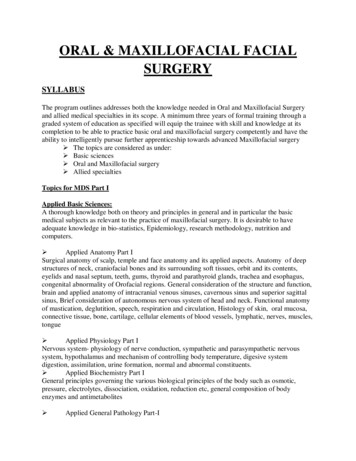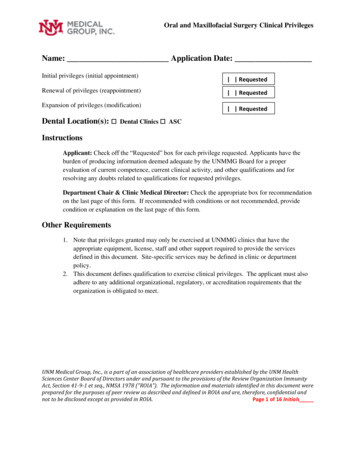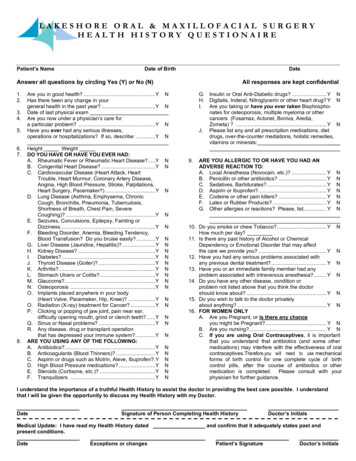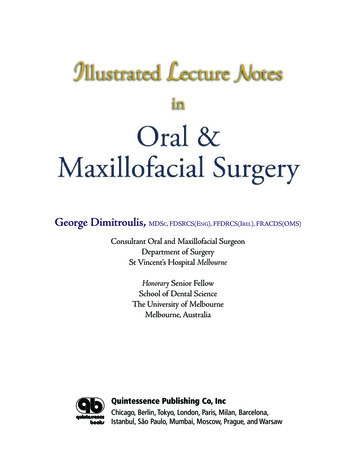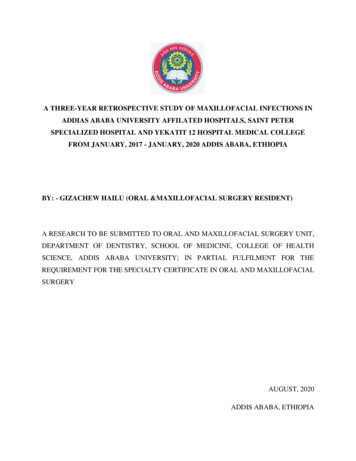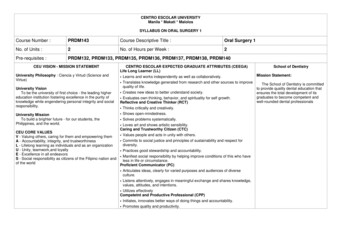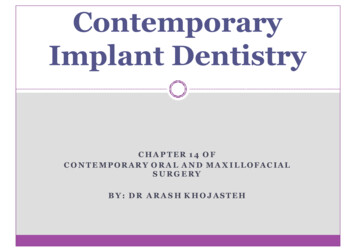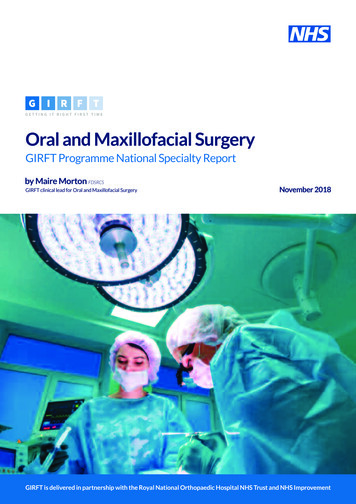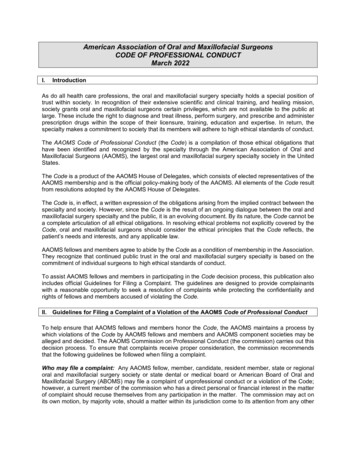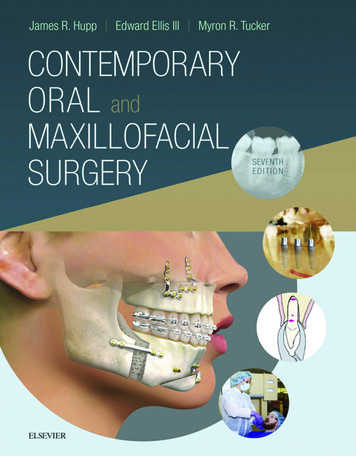
Transcription
Any screen.Any time.Anywhere.Activate the eBook versionof this title at no additional charge.Expert Consult eBooks give you the power to browse and find content,view enhanced images, share notes and highlights—both online and offline.Unlock your eBook today.1 Visit expertconsult.inkling.com/redeem2Scan this QR code to redeem youreBook through your mobile device: Scratch off your code3 Type code into “Enter Code” box4 Click “Redeem”5 Log in or Sign up6 Go to “My Library”Place Peel OffSticker HereIt’s that easy!For technical assistance:email expertconsult.help@elsevier.comcall 1-800-401-9962 (inside the US)call 1-314-447-8200 (outside the US)Use of the current edition of the electronic version of this book (eBook) is subject to the terms of the nontransferable, limited license granted onexpertconsult.inkling.com. Access to the eBook is limited to the first individual who redeems the PIN, located on the inside cover of this book,at expertconsult.inkling.com and may not be transferred to another party by resale, lending, or other means.2015v1.0
CONTEMPORARYORAL andMAXILLOFACIALSURGERY
This page intentionally left blank
SEVENTHEDITIONCONTEMPORARYORAL andMAXILLOFACIALSURGERYJames R. Hupp, DMD, MD, JD, MBAVice Dean for Student and Faculty ExperienceProfessor of SurgeryElson S. Floyd College of MedicineWashington State UniversitySpokane, Washington;Founding Dean and Professor EmeritusSchool of Dental MedicineEast Carolina UniversityGreenville, North CarolinaEdward Ellis III, DDS, MSProfessor and ChairDepartment of Oral and Maxillofacial SurgeryUniversity of Texas Health Science CenterSan Antonio, TexasMyron R. Tucker, DDSOral and Maxillofacial Surgery Education ConsultantCharlotte, North CarolinaIsle of Palms, South Carolina;Adjunct Clinical ProfessorDepartment of Oral and Maxillofacial SurgeryLouisiana State UniversityNew Orleans, Louisiana
1600 John F. Kennedy Blvd.Ste 1800Philadelphia, PA 19103-2899CONTEMPORARY ORAL AND MAXILLOFACIAL SURGERY,SEVENTH EDITIONISBN: 978-0-323-55221-9Copyright 2019 by Elsevier, Inc. All rights reserved.No part of this publication may be reproduced or transmitted in any form or by any means, electronicor mechanical, including photocopying, recording, or any information storage and retrieval system, withoutpermission in writing from the publisher. Details on how to seek permission, further information about thePublisher’s permissions policies and our arrangements with organizations such as the Copyright Clearance Centerand the Copyright Licensing Agency, can be found at our website: www.elsevier.com/permissions.This book and the individual contributions contained in it are protected under copyright by the Publisher (otherthan as may be noted herein).NoticePractitioners and researchers must always rely on their own experience and knowledge in evaluating and usingany information, methods, compounds or experiments described herein. Because of rapid advances in themedical sciences, in particular, independent verification of diagnoses and drug dosages should be made. To thefullest extent of the law, no responsibility is assumed by Elsevier, authors, editors or contributors for anyinjury and/or damage to persons or property as a matter of products liability, negligence or otherwise, or fromany use or operation of any methods, products, instructions, or ideas contained in the material herein.Previous editions copyrighted 2014, 2008, 2003, 1998, 1993, 1988 by Mosby, Inc., an affiliate of Elsevier, Inc.Library of Congress Control Number: 2018944860Content Strategist: Alexandra MortimerSenior Content Development Manager: Kathryn DeFrancescoPublishing Services Manager: Catherine JacksonSenior Project Manager/Specialist: Carrie StetzDesign Direction: Patrick FergusonPrinted in ChinaLast digit is the print number: 987654321
My contributions to this book are dedicated to my wonderfully supportive family:Carmen, my wife, best friend, and the love of my life; our children,Jamie, Justin, Joelle, and Jordan; our daughters and sons-in-law,Natacha, Joe, Jordan, and Ted; and our precious grandchildren,Peyton, Morgan, and Owen.James R. HuppTo all of the people I have worked with for the past 40 yearsin oral and maxillofacial surgery, including my mentors,partners in practice, residents, students,and the staff that has offered me so much support.You all know who you are.Myron R. TuckerTo the many students and residents who have allowedme to take part in their education.Edward Ellis III
ContributorsRichard Bauer, DMD, MDAssistant ProfessorDepartment of Oral and Maxillofacial SurgeryUniversity of PittsburghPittsburgh, PennsylvaniaTroy R. Eans, DMDClinical Assistant ProfessorProsthodonticsUniversity of PittsburghPittsburgh, PennsylvaniaEdward Ellis III, DDS, MSProfessor and ChairOral and Maxillofacial SurgeryUniversity of Texas Health Science CenterSan Antonio, TexasBrian Farrell, DDS, MD, FACSPrivate Practice and Fellowship DirectorCarolinas Center for Oral and Facial SurgeryCharlotte, North Carolina;Assistant Clinical ProfessorDepartment of Oral and Maxillofacial SurgeryLouisiana State University Health Science CenterNew Orleans, LouisianaTirbod Fattahi, DDS, MD, FACSProfessor and ChairDepartment of Oral and Maxillofacial SurgeryUniversity of Florida College of MedicineJacksonville, FloridaMichael Han, DDSAssistant ProfessorOral and Maxillofacial SurgeryUniversity of Illinois at ChicagoChicago, IllinoisMichaell Huber, DDSProfessor & DiplomateAmerican Board of Oral MedicineDepartment of Comprehensive DentistryUT Health San Antonio School of DentistrySan Antonio, TexasviJames Hupp, DMD, MD, JD, MBAVice Dean for Student and Faculty ExperienceProfessor of SurgeryElson S. Floyd College of MedicineWashington State UniversitySpokane, Washington;Founding Dean and Professor EmeritusSchool of Dental MedicineEast Carolina UniversityGreenville, North CarolinaAntonia Kolokythas, DDS, MSc, FACSHead and Program DirectorOral and Maxillofacial SurgeryUniversity of RochesterRochester, New YorkStuart Lieblich, DMDClinical ProfessorOral and Maxillofacial SurgeryUniversity of ConnecticutFarmington, Connecticut;Private PracticeAvon Oral and Maxillofacial SurgeryAvon, ConnecticutMichael R. Markiewicz, DDS, MPH, MDAssistant ProfessorOral and Maxillofacial SurgeryUniversity of Illinois at Chicago Cancer Center;Assistant ProfessorFeinberg School of MedicineNorthwestern University;Assistant ProfessorAnn & Robert H. Lurie Children’s HospitalChicago, IllinoisMichael Miloro, DMD, MD, FACSProfessor, Department Head, and Program DirectorOral and Maxillofacial SurgeryUniversity of IllinoisChicago, IllinoisJohn Nale, DMD, MD, FACSAssistant Clinical ProfessorOral and Maxillofacial SurgeryLouisiana State University Health Science CenterNew Orleans, Louisiana;Private PracticeCarolinas Center for Oral and Facial SurgeryCharlotte, North Carolina
ContributorsEdward M. Narcisi, DMDAssistant Clinical ProfessorDepartment of Restorative DentistryClinical Co-Director, Multi-Disciplinary Implant CenterClinical Co-Director, University of Pittsburgh Medical CenterPresbyterian/ShadysideSchool of Dental MedicineUniversity of Pittsburgh;Private PracticePittsburgh, PennsylvaniaMark W. Ochs, DMD, MDProfessor and ChairDepartment of Oral and Maxillofacial SurgerySchool of Dental MedicineUniversity of Pittsburgh;ProfessorOtolaryngology–Head and Neck SurgeryUniversity of Pittsburgh Medical CenterPittsburgh, PennsylvaniaSalam O. Salman, DDS, MD, FACSResidency Program Director and Assistant ProfessorDepartment of Oral and Maxillofacial SurgeryUniversity of Florida College of MedicineJacksonville, FloridaMyron R. Tucker, DDSOral and Maxillofacial Surgery Educational ConsultantCharlotte, North CarolinaIsle of Palms, South Carolina;Adjunct Clinical ProfessorDepartment of Oral and Maxillofacial SurgeryLouisiana State UniversityNew Orleans, LouisianaAlison Yeung, DDS, MDClinical Assistant ProfessorDivision of Oral and Maxillofacial SurgerySchool of Dental MedicineEast Carolina UniversityGreenville, North Carolinavii
PrefaceThe seventh edition of this internationally adopted and highlypraised textbook, Contemporary Oral and Maxillofacial Surgery,is designed to provide both dental trainees and practicingdentists the fundamental principles of clinical evaluation,treatment planning, and surgical care for patients with diseasesand deformities of the oral and maxillofacial region. This bookprovides great detail on the foundational techniques of evaluation,diagnosis, and care for clinical problems commonly managedby the general dental practitioner. The extensive number ofillustrations make the surgical techniques readily understandable and also enhance readers’ appreciation of the biologicbasis and technical fundamentals, allowing them to manageroutine surgical situations as well as those that go beyond“textbook cases.”There are two major purposes of the seventh edition ofContemporary Oral and Maxillofacial Surgery: (1) to present acomprehensive description of the basic oral surgery proceduresthat are performed by general practitioners, and (2) to provideinformation on advanced, more complex surgical evaluation andmanagement of patients with problems that are typically managedby oral and maxillofacial surgeons but are commonly first seenand evaluated by other dental practitioners.Whether you are a dental student, resident, or already inpractice, the seventh edition of Contemporary Oral and Maxillofacial Surgery is an excellent resource to add to your professionallibrary and regularly return to while providing patient care.New to This EditionChapters 1 and 2, “Preoperative Health Status Evaluation” and“Prevention and Management of Medical Emergencies.” Thesechapters have been completely updated.Chapter 6, “Pain and Anxiety Control in Surgical Practice.”This is an entirely new chapter providing succinct presentationof local anesthesia and nitrous oxide sedation as they relate tooffice-based oral surgery.Chapter 8, “Principles of Routine Exodontia.” New photographs and illustrations help enhance understanding of routineexodontic procedures.viiiChapter 11, “Postextraction Patient Management.” This chapterprovides comprehensive information on preventing and managingthe postoperative sequelae and complications of exodontia.Chapter 12, “Medicolegal Considerations.” This chapter hasbeen updated with the most current HIPAA and Affordable HealthCare Act information that affects dentistry and oral and maxillofacialsurgery.Chapter 15, “Implant Treatment: Advanced Concepts andComplex Cases.” This chapter has been updated with the latestvirtual planning options and new cases.Chapter 20, “Odontogenic Diseases of the Maxillary Sinus.”This chapter includes updated medical management and treatmentwith endoscopic procedures.Chapter 21, “Diagnosis and Management of Salivary GlandDisorders.” This chapter includes updates on imaging techniquesand medical management.Chapter 25, “Management of Facial Fractures.” New cases havebeen added, with emphasis on the most recent imaging and navigation applications.Chapter 26, “Correction of Dentofacial Deformities.” The mostcurrent applications of computerized virtual surgical planning havebeen expanded. New illustrations using Dolphin Aquarium technology have been added to demonstrate surgical osteotomies, alongwith many new case reports.Chapter 27, “Facial Cosmetic Surgery.” This chapter has beenrewritten by a new author emphasizing the full scope of facialcosmetic surgery, including surgical and nonsurgical treatment ofthe aging face.Chapter 28, “Management of Temporomandibular Disorders.”Updates on nonsurgical medical management have been addressed.The latest concepts of reconstruction of severe temporomandibularjoint degeneration and the current technology for joint replacementhave been augmented.Chapter 29, “Surgical Reconstruction of Defects of the Jaws.”This chapter includes new information on the use of a combinationof bone morphogenetic protein, bone marrow aspirate cell concentrate, and allogeneic bone to reconstruct the jaws without theneed for procurement of large autogenous bone grafts.
AcknowledgmentsThank you to Katie DeFrancesco for her patience and hard workmanaging the production of this seventh edition. I appreciateMakani Dollinger, Cameron McGee, Jordan White, and AlisonYeung for agreeing to pose for the new photographs in this edition,and for Steven Lichti for taking the photos. I also wish to expressmy gratitude to my faculty colleagues, Drs. Alison Yeung andSteven Thompson, for their support while I was preparing mycontributions.James R. HuppI thank my daughter, Ashley Tucker, for all the graphic designwork she has done for my publications over the past 12 years.Myron R. TuckerI am indebted to all those who have furthered my education. Thatlist includes my teachers, my colleagues, and my residents.Edward Ellis IIIix
This page intentionally left blank
ContentsPart I: Principles of Surgery, 1114Preoperative Health Status Evaluation, 2Implant Treatment: Basic Concepts andTechniques, 251Edward M . Narcisi, Myron R. Tucker, and Richard E. BauerJames R. Hupp and Alison Yeung1523Prevention and Management of MedicalEmergencies, 20James R. Hupp and Alison YeungPrinciples of Surgery, 38James R. HuppMyron R. Tucker, Richard E. Bauer, Troy R. Eans,and Mark 1/1/. OchsPart IV: Infections, 317Wound Repair, 44Principles of Management and Preventionof Odontogenic Infections, 318James R. HuppMichael D. Han, Michael R. Markiewicz, and Michael Miloro1645Infection Control in Surgical Practice, 5617Pain and Anxiety Control in SurgicalPractice, 68James R. HuppComplex Odontogenic Infections, 335Michael R. Markiewicz, Michael D. Han, and Michael MiloroJames R. Hupp6Implant Treatment: Advanced Concepts andComplex Cases, 28118Principles of Endodontic Surgery, 364Stuart E. Lieblich19Part II: Principles of Exodontia, 82Management of the Patient UndergoingRadiotherapy or Chemotherapy, 390Edward Ellis III7Instrumentation for Basic Oral Surgery, 83James R. Hupp20Odontogenic Diseases of the Maxillary Sinus, 410Myron R. Tucker and Richard E. Bauer8Principles of Routine Exodontia, 106James R. Hupp921Diagnosis and Management of Salivary GlandDisorders, 423Michael Miloro and Antonia KolokythasPrinciples of More Complex Exodontia, 135James R. Hupp10Principles of Management of ImpactedTeeth, 160James R. Hupp11PartV: Management of Oral PathologicLesions, 45022Postextraction Patient Management, 185Edward Ellis III and Michael! A. HuberJames R. Hupp2312Medicolegal Considerations, 204Myron R. Tucker and James R. HuppPart III: Preprosthetic and ImplantSurgery, 21613Preprosthetic Surgery, 217Myron R. Tucker and Richard E. BauerPrinciples of Differential Diagnosis andBiopsy, 451Surgical Management of Oral PathologicLesions, 477Edward Ellis IIIPARTVI: Oral and MaxillofacialTrauma, 49724Soft Tissue and Dentoalveolar Injuries, 498Edward Ellis IIIXI
XII25ContentsManagement of Facial Fractures, 519Mark W. Ochs, Myron R. Tucker, and Richard E. Bauer31Management of TemporomandibularDisorders, 652John C. Nale and Myron R. TuckerPart VII: Dentofacial Deformities, 54626Correction of Dentofacial Deformities, 547Myron R. Tucker, Brian B. Farrell, and Richard E. Bauer27Facial Cosmetic Surgery, 593Tirbod Fattahi and Salam Salman28Management of Patients With OrofacialClefts, 608Edward Ellis III29Surgical Reconstruction of Defectsof the Jaws, 628Edward Ellis IIIPart VIII: Temporomandibular and OtherFacial Pain Disorders, 64230Facial Neuropathology, 643James R. HuppAppendix 1 Operative Note (Office Record )Component Parts, 681Appendix 2 Drug Enforcement Administration Scheduleof Drugs and Examples, 682Appendix 3 Examples of Useful Prescriptions, 683Appendix 4 Consent for Extractions andAnesthesia, 684Appendix 5 Antibiotic Overview, 685Index, 687
Principles of Surgeryhttps://t.me/LibraryEDentSurgery is a discipline based on principles that have evolved from basic research and centuriesof trial and error. These principles pervade every area of surgery, whether oral and maxillofacial,periodontal, or gastrointestinal. Part I provides information about patient health evaluation,managing medical emergencies, surgical concepts, principles of asepsis, and pain and anxietycontrol, which together form the necessary foundation for presentations of the specializedsurgical techniques in succeeding chapters in this book.Many patients have medical conditions that affect their ability to tolerate oral and maxillofacial surgery and anesthesia. Chapter 1 discusses the process of evaluating the health statusof patients. This chapter also describes methods of modifying surgical treatment plans tosafely accommodate patients with the most common medical problems.Preventing medical emergencies in the patient undergoing oral and maxillofacial surgeryor other forms of dentistry is always easier than managing emergencies should they occur.Chapter 2 discusses the means of recognizing and managing common medical emergenciesin the dental office. Just as important, Chapter 2 also provides information about measuresto lower the probability of emergencies.Contemporary surgery is guided by a set of guiding principles, most of which apply nomatter where in the body they are put into practice. Chapter 3 covers the most importantprinciples for those practitioners who perform surgery of the oral cavity and maxillofacialregions.Surgery always leaves a wound, whether one was initially present or not. Although obvious,this fact is often forgotten by the inexperienced surgeon, who may act as if the surgicalprocedure is complete once the final suture has been tied and the patient leaves. The surgeon’sprimary responsibility to the patient continues until the wound has healed; therefore anunderstanding of wound healing is mandatory for anyone who intends to create woundssurgically or manage accidental wounds. Chapter 4 presents basic wound healing concepts,particularly as they relate to oral surgery.The work of Semmelweiss and Lister in the 1800s made clinicians aware of the microbialorigin of postoperative infections, thereby changing surgery from a last resort to a more predictably successful endeavor. The advent of antibiotics designed to be used systemically furtheradvanced surgical science, allowing elective surgery to be performed at low risk. However,pathogenic communicable organisms still exist, and when the epithelial barrier is breachedduring surgery, these can cause wound infections or systemic infectious diseases. The mostserious examples are the hepatitis B virus and human immunodeficiency virus. In addition,microbes resistant to even to the most powerful antimicrobials today are emerging, makingsurgical asepsis more important than ever. Chapter 5 describes the means of minimizing therisk of significant wound contamination and the spread of infectious organisms among individuals. This includes thorough decontamination of surgical instruments, disinfection of the roomin which surgery is performed, lowering of bacterial counts in the operative site, and adherenceto infection control principles by the members of the surgical team—in other words, strictadherence to aseptic technique.Finally, Chapter 6 covers the common methods used by those performing oral surgery tocontrol pain and anxiety, primarily through the use of local anesthesia and nitrous oxidesedation.@LibraryEDent ﻣﻛﺗﺑﺔ طب اﻷﺳﻧﺎن PART I1
1CHAPTER OUTLINEMedical History, 2Biographic Data, 3Chief Complaint, 3History of Chief Complaint, 3Medical History, 3Review of Systems, 6Physical Examination, 6Management of Patients With Compromising MedicalConditions, 8Cardiovascular Problems, 8Ischemic Heart Disease, 8Cerebrovascular Accident (Stroke), 10Dysrhythmias, 10Heart Abnormalities That Predispose to InfectiveEndocarditis, 10Congestive Heart Failure (Hypertrophic Cardiomyopathy), 10Pulmonary Problems, 11Asthma, 11Chronic Obstructive Pulmonary Disease, 12Renal Problems, 12Renal Failure, 12Renal Transplantation and Transplantation of Other Organs, 12Hypertension, 13Hepatic Disorders, 13Endocrine Disorders, 13Diabetes Mellitus, 13Adrenal Insufficiency, 15Hyperthyroidism, 15Hypothyroidism, 15Hematologic Problems, 15Hereditary Coagulopathies, 15Therapeutic Anticoagulation, 16Neurologic Disorders, 17Seizure Disorders, 17Ethanolism (Alcoholism), 17Management of Patients During and After Pregnancy, 17Pregnancy, 17Postpartum, 192The extent of the medical history, physical examination, andlaboratory evaluation of patients requiring outpatientdentoalveolar surgery, under local anesthesia, nitrous oxidesedation, or both, differs substantially from that necessary for apatient requiring hospital admission and general anesthesia forsurgical procedures. A patient’s primary care physician typicallyperforms periodic comprehensive history taking and physicalexamination of patients; it is therefore impractical and of littlevalue for the dentist to duplicate this process. However, the dentalprofessional must discover the presence or history of medicalproblems that may affect the safe delivery of the care she or heplans to provide, as well as any conditions specifically affectingthe health of the oral and maxillofacial regions. This is particularlytrue for patients for which dentoalveolar surgery is planned. Thisis due to several factors such as the added physical stress surgerypatient experience, the creation of a bleeding wound that thenneeds to heal, the invasive nature of surgery that typically introducesmicroorganisms into the patients tissues, and the common needfor more elaborate pain and anxiety control measures and the useof more potent agents.Dentists are educated in the basic biomedical sciences and thepathophysiology of common medical problems, particularly asthey relate to the maxillofacial region. This special expertise inmedical topics as they relate to the oral region makes dentistsvaluable resources on the community health care delivery team.The responsibility this carries is that dentists must be capable ofrecognizing and appropriately managing pathologic oral conditions.To maintain this expertise, a dentist must keep informed of newdevelopments in medicine, be vigilant while treating patients, andbe prepared to communicate a thorough but succinct evaluationof the oral health of patients to other health care providers.Medical HistoryAn accurate medical history is the most useful information aclinician can have when deciding whether a patient can safelyundergo planned dental therapy. The dentist must be preparedto anticipate how a medical problem or problems might alter apatient’s response to planned anesthetic agents and surgery. Ifthe history taking is done well, the physical examination andlaboratory evaluation of a patient usually play lesser roles in thepresurgical evaluation. The standard format used for recordingthe results of medical histories and physical examinations isillustrated in Box 1.1. This general format tends to be followedeven in electronic medical records.The medical history interview and the physical examinationshould be tailored to each patient, taking into considerationthe patient’s medical problems, age, intelligence, and socialhttps://t.me/LibraryEDentJAMES R. HUPP AND ALISON YEUNG@LibraryEDent ﻣﻛﺗﺑﺔ طب اﻷﺳﻧﺎن Preoperative Health Status Evaluation
Biographic dataChief complaint and its historyMedical historySocial and family medical historiesReview of systemsPhysical examinationLaboratory and imaging resultscircumstances; the complexity of the planned procedure; and theanticipated anesthetic methods.Biographic DataThe first information to obtain from a patient is biographic data.These data include the patient’s full name, home address, age,gender, and occupation, as well as the name of the patient’s primarycare physician. The clinician uses this information, along with animpression of the patient’s intelligence and personality, to assessthe patient’s reliability. This is important because the validity ofthe medical history provided by the patient depends primarily onthe reliability of the patient as a historian. If the identificationdata and patient interview give the clinician reason to suspect thatthe medical history may be unreliable, alternative methods ofobtaining the necessary information should be tried. A reliabilityassessment should continue throughout the entire history interviewand physical examination, with the interviewer looking for illogical,improbable, or inconsistent patient responses that might suggestthe need for corroboration of information.Chief ComplaintEvery patient should be asked to state their chief complaint. Thiscan be accomplished on a form the patient completes, or thepatient’s answers should be transcribed (preferably verbatim) intothe dental record during the initial interview by a staff memberor the dentist. This statement helps the clinician establish prioritiesduring history taking and treatment planning. In addition, havingpatients formulate a chief complaint encourages them to clarifyfor themselves and the clinician why they desire treatment. Occasionally, a hidden agenda may exist for the patient, consciously orsubconsciously. In such circumstances, subsequent informationelicited from the patient interview may reveal the true reason thepatient seeks care.History of Chief ComplaintThe patient should be asked to describe the history of the presentcomplaint or illness, particularly its first appearance, any changessince its first appearance, and its influence on or by other factors. Forexample, descriptions of pain should include date of onset, intensity,duration, location, and radiation, as well as factors that worsen andmitigate the pain. In addition, an inquiry should be made aboutconstitutional symptoms such as fever, chills, lethargy, anorexia,malaise, and any weakness associated with the chief complaint.This portion of the health history may be straightforward, suchas a 2-day history of pain and swelling around an erupting thirdmolar. However, the chief complaint may be relatively involved,such as a lengthy history of a painful, nonhealing extraction site BOX 1.2Baseline Health History Database1. Past hospitalizations, operations, traumatic injuries, and serious illnesses2. Recent minor illnesses or symptoms3. Medications currently or recently in use and allergies (particularly drugallergies)4. Description of health-related habits or addictions, such as the use ofethanol, tobacco, and illicit drugs; and the amount and type of dailyexercise5. Date and result of last medical checkup or physician visitin a patient who received therapeutic irradiation. In this morecomplex case, a more detailed history of the chief complaint isimportant to obtain.Medical HistoryMost dental practitioners find health history forms (questionnaires) to be an efficient means of initially collecting the medicalhistory, whether obtained in writing or in an electronic format.When a credible patient completes a health history form, thedentist can use pertinent answers to direct the interview. Properlytrained dental assistants can “red flag” important patient responseson the form (e.g., circling allergies to medications in red orelectronically flagging them) to bring positive answers to thedentist’s attention.Health questionnaires should be written clearly, in nontechnicallanguage, and in a concise manner. To lessen the chance of patientsgiving incomplete or inaccurate responses, and to comply withHealth Insurance Portability and Accountability Act regulations,the form should include a statement that assures the patient of theconfidentiality of the information and a consent line identifyingthose individuals the patient approves of having access to the dentalrecord, such as the primary care physician and other clinicians inthe practice. The form should also include a way (e.g., a signatureline or pad) for the patient to verify that he or she has understoodthe questions and the accuracy of the answers. Numerous healthquestionnaires designed for dental patients are available from sourcessuch as the American Dental Association and dental textbooks(Fig. 1.1).Answers to the items listed in Box 1.2 (collected on a form viatouch screen or verbally) help establish a suitable health historydatabase for patients; if the data are collected verbally, subsequentwritten documentation of the results is important.In addition to this basic information, it is helpful to inquirespecifically about common medical problems that are likely to alterthe dental management of the patient. These problems includeangina, myocardial infarction (MI), heart murmurs, rheumaticheart disease, bleeding disorders (including anticoagulant use),asthma, chronic lung disease, hepatitis, sexually transmittedinfections, diabetes, corticosteroid use, seizure disorder, stroke,and any implanted prosthetic device such as artificial joint orheart valve. Patients should be asked specifically about allergiesto local anesthetics, aspirin, and penicillin. Female patients in theappropriate age group must be asked at each visit whether theyare or may be pregnant.A brief family history can be useful and should focus on relevantinherited diseases such as hemophilia (Box 1.3). The medical historyshould be regularly updated. Many dentists have their assistantsspecifically ask each patient at checkup appointments whetherthere has been any change in health since the last dental visit. The@LibraryEDent ﻣﻛﺗﺑﺔ طب اﻷﺳﻧﺎن 1.2.3.4.5.6.7.Standard Format for Recording Results ofHistory and Physical Examinations3https://t.me/LibraryEDent BOX 1.1n CHAPTER 1 Preoperative Health Status Evaluatio
Principles of SurgeryMEDICAL HISTORYMNameFDate of BirthAddressTelephone: (Home)Today’s Date(Work)HeightWeightOccupationAnswer all questions by circling either YES or NO and fill in all blank spaces where indicated.Answers to the following questions are for our records only and are confidential.1. My last medical physical examination was on (ap
praised textbook, Contemporary Oral and Maxillofacial Surgery, is designed to provide both dental trainees and practicing dentists the fundamental principles of clinical evaluation, treatment planning, and surgical care for patients with diseases and deformities of the oral and maxillofacial region. This book
